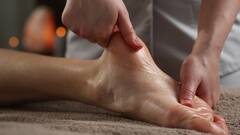Breast Cancer Awareness Month 2023: Know The Role Of Exercise And Physical Activity For Breast Cancer Patients
Beyond its traditional benefits in improving physical fitness, exercise has emerged as a crucial ally in the fight against breast cancer, contributing to physical and emotional well-being of patients.

The role of exercise in breast cancer treatment represents a pivotal and increasingly recognised aspect of holistic care for individuals facing this challenging health issue. Beyond its traditional benefits in improving physical fitness, exercise has emerged as a crucial ally in the fight against breast cancer, contributing to both the physical and emotional well-being of patients. In this article we will discuss the importance of exercise and yoga in managing breast cancer.
Role Of Exercise In Managing Breast Cancer:
Dr Annu Prasad, who is an Ayurvedic consultant at Birla Ayurveda mentioned that regular exercise helps lower physical and mental stress while raising oxygen levels in the body.
- Exercise before, during, and after receiving radiation, hormonal, and targeted therapies, as well as before, during, and after undergoing chemotherapy and surgery.
- There is no doubt that being overweight or obese increases the chance of acquiring numerous cancers, including breast cancer in postmenopausal women. Immune system activity, inflammation, and oestrogen and IGF-1 levels are thought to have a role in the relationship between obesity and breast cancer.
- Regaining or improving physical functions, aerobic capacity, strength, flexibility, body image, body composition, quality of life, the capacity to physically and psychologically withstand any current and/or future cancer treatments, and the capacity to withstand anxiety due to living with a current or recurrent disease are all indications for exercise treatment in this patient population. Additionally, signs include a decrease in cancer treatment's long-term and late effects and a probable delay in any recurrence or progress of the disease.
- Pilates exercises enhance physical stamina, flexibility, and postural control, and in industrialised nations, women frequently accept them as a kind of exercise. Pilates workouts significantly improve functional ability, fatigue, flexibility, and quality of life in females with breast cancer when compared to the control group, according to a randomised clinical investigation.
Yoga Poses That Can Help:
Yoga may be calming and rejuvenating. Yoga is another form of contemplative exercise that breast cancer patients can benefit from because it incorporates breathing, posture, flexibility, and core strength exercises. A research on breast cancer patients was published in 2013 and found that weekly Yoga therapy enhanced physical function.
Several cancer-related yoga poses suggested by Dr Annu Prasad that can be practised are:
1- Balasana
2- Pranayam
3- Uttanasan
4- Viparita Karani
5- Savasana
Yash Agarwal who is the Founder of Yash Fitness shared the following tips related to physical activity for breast cancer patients:
- Consult with your healthcare team: Always seek medical advice before starting any exercise regimen.
- Gradual progression: Begin with low-intensity activities and slowly increase intensity over time.
- Aerobic exercises: Engage in activities like walking, swimming, or cycling to improve cardiovascular health.
- Strength training: Incorporate weight lifting or resistance band exercises to build muscle and bone strength.
- Flexibility exercises: Practice stretching to maintain joint mobility and prevent stiffness.
- Balance exercises: Enhance stability with yoga or tai chi to reduce the risk of falls.
- Frequency: Aim for at least 150 minutes of moderate-intensity aerobic exercise per week.
- Intensity: Exercise at a level that raises your heart rate but allows you to hold a conversation.
- Rest days: Include rest days to allow your body to recover and prevent overexertion.
- Warm-up and cool-down: Always start with a warm-up and finish with a cool-down to prevent injury.
- Posture awareness: Focus on maintaining good posture during exercises to avoid strain.
- Target different muscle groups: Ensure a balanced workout by targeting various muscle groups.
- Pain management: Communicate any discomfort to your healthcare provider to adjust your exercise routine.
- Monitoring vital signs: Keep an eye on heart rate and blood pressure during exercise.
- Bone health: Weight-bearing exercises like walking can help improve bone density.
- Lymphedema precautions: If you have lymphedema, wear compression garments and avoid strenuous activities.
- Fatigue management: Exercise can combat cancer-related fatigue but adjust intensity based on energy levels.
- Nutritional support: Maintain a balanced diet to support your physical activity.
- Hydration: Stay well-hydrated, especially during exercise.
- Sleep: Prioritize good sleep hygiene for recovery.
- Avoid excessive sun exposure: Protect your skin during outdoor activities to prevent skin damage.
Top Headlines
Trending News






































